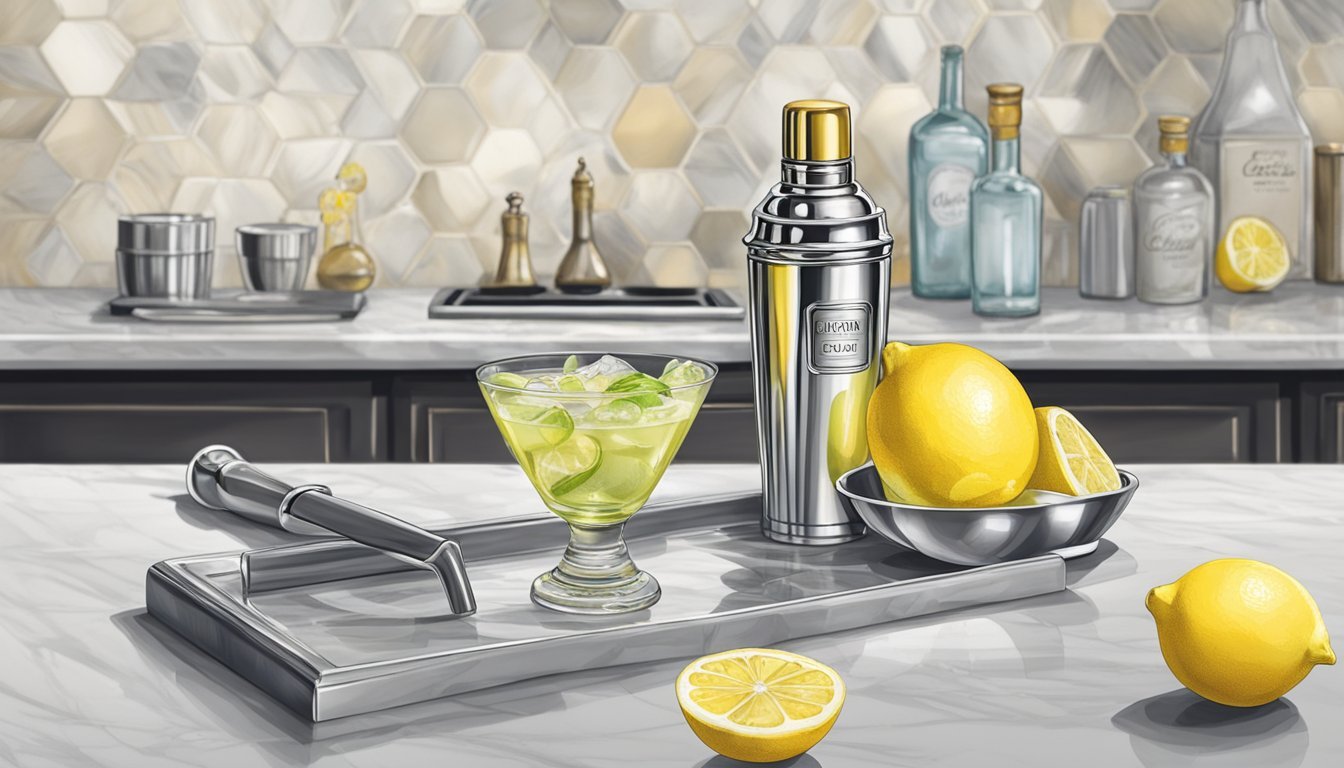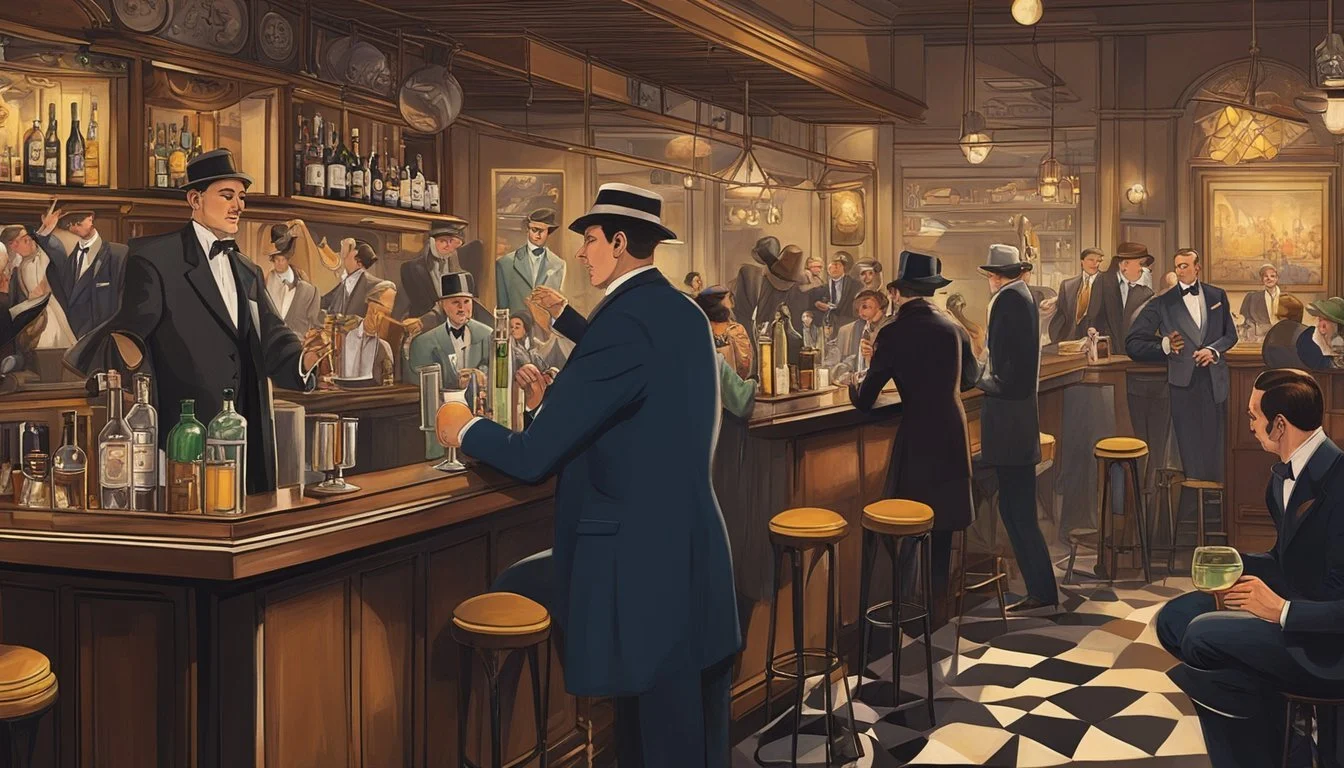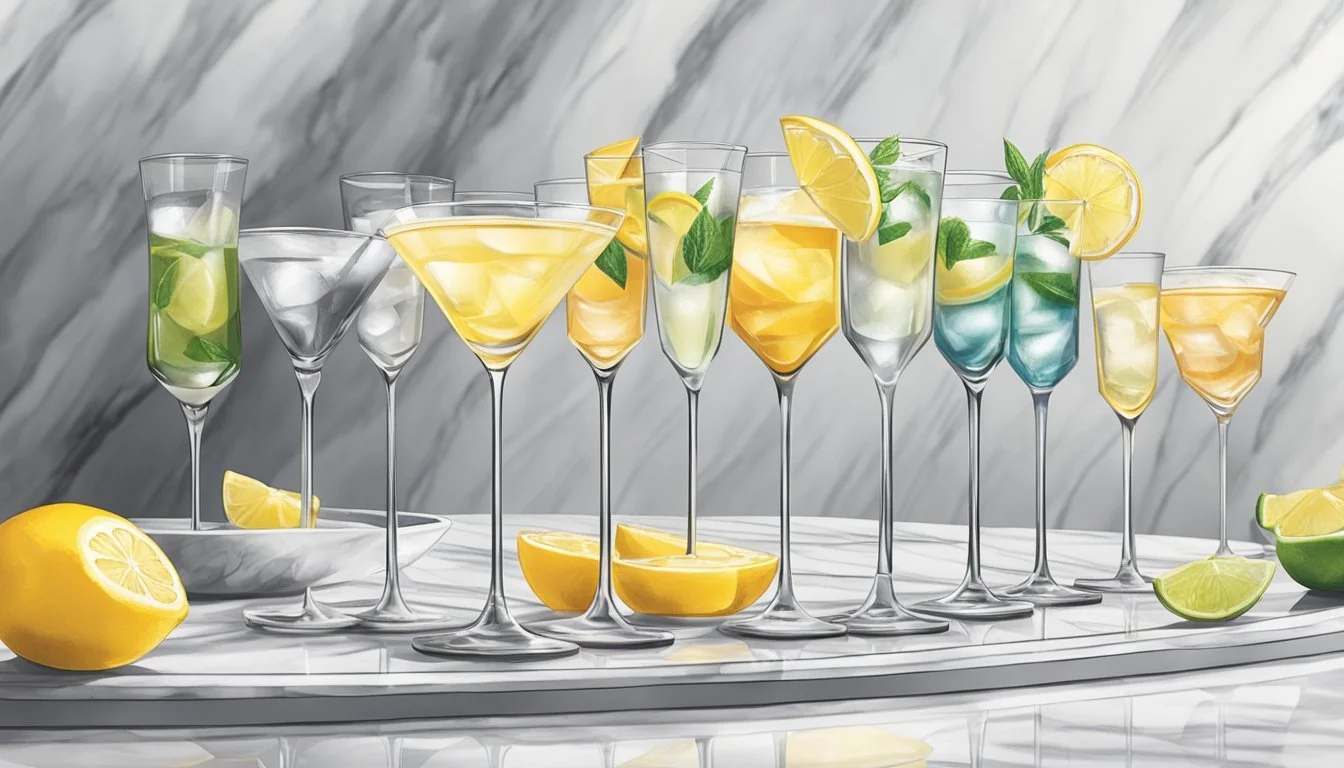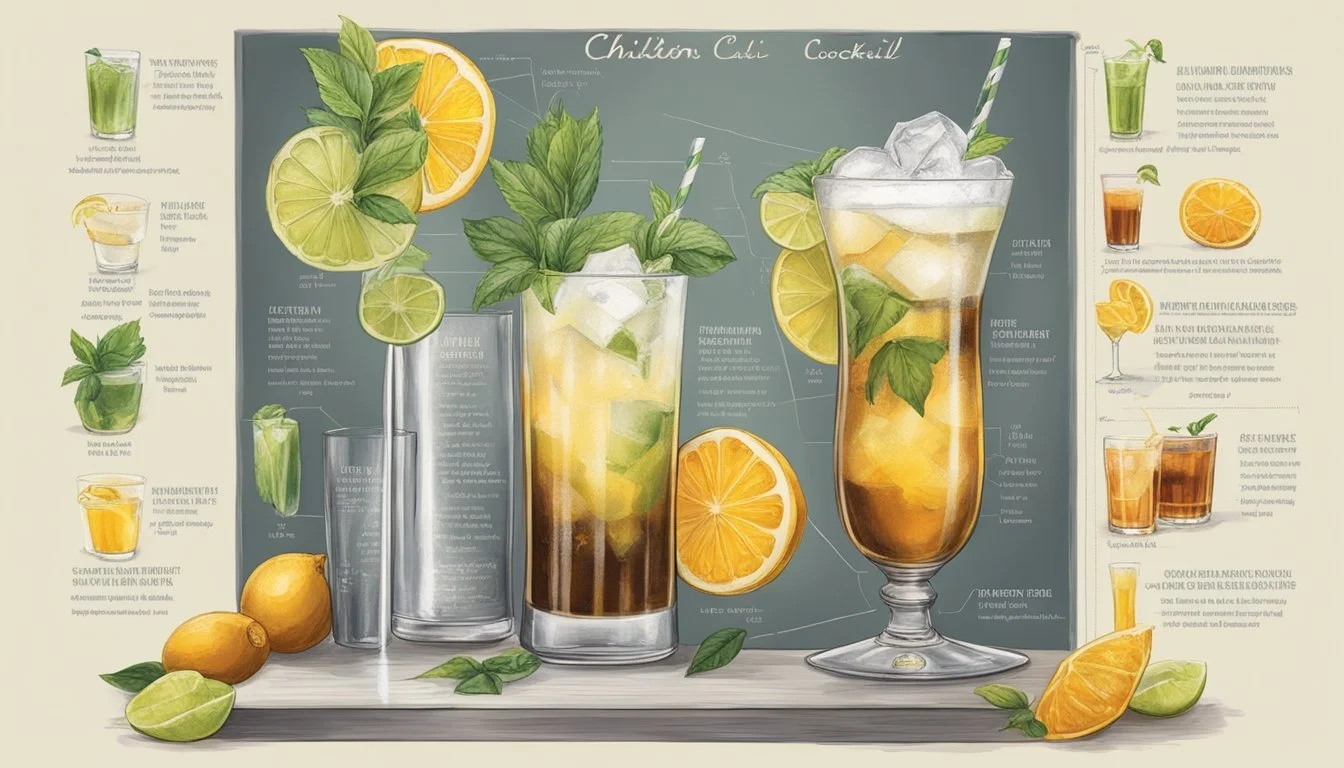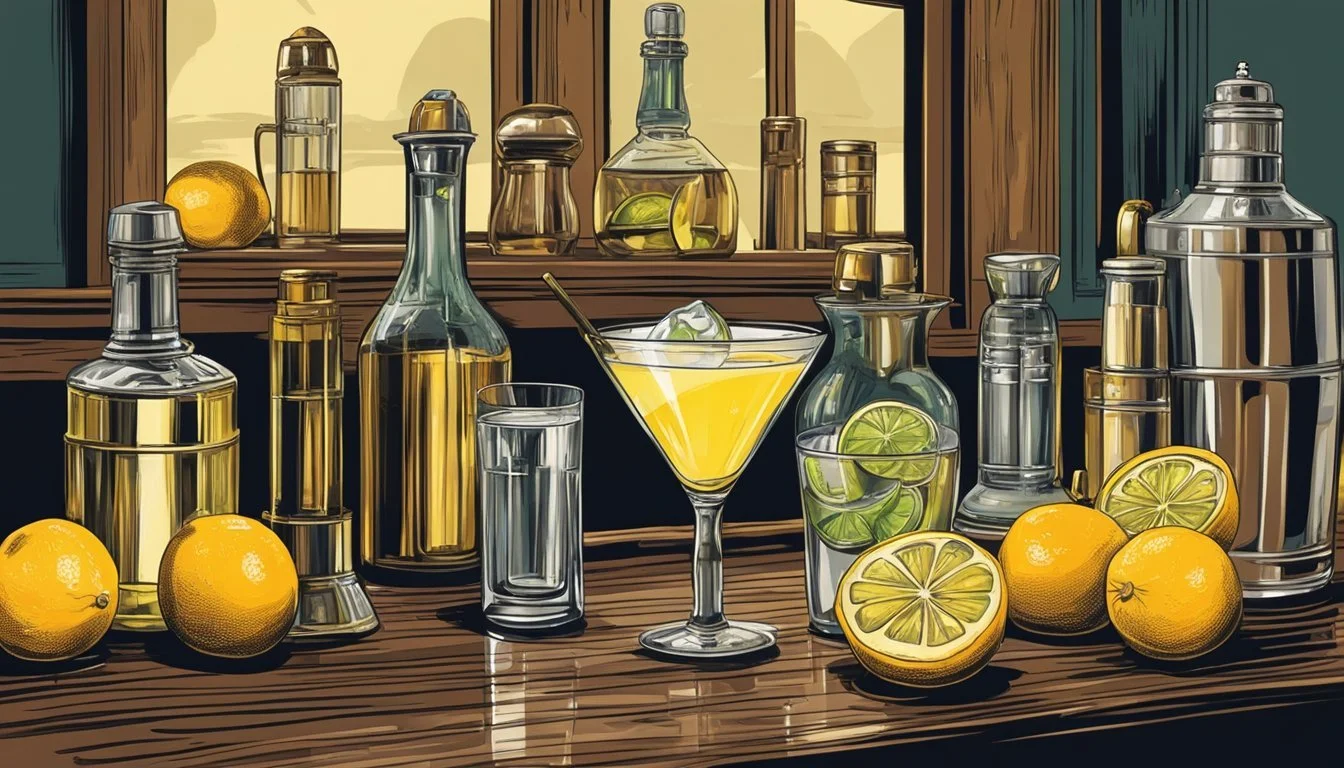The History of the Chilton Cocktail
Unveiling the Drink's Origins and Evolution
The Chilton Cocktail stands as a testament to the inventive spirit of West Texas, especially within its birthplace of Lubbock. This refreshing, lemony cocktail has its unassuming origins within the walls of Lubbock Country Club, where, as local lore and Texas Monthly recount, a Lubbock doctor named Dr. Chilton conceived the drink. Seeking a distinctive beverage that could offer reprieve from the Texan heat, Dr. Chilton, allegedly a Texas Tech alumnus, instructed the bartender to mix lemon juice with vodka and soda water.
The recipe for the Chilton is deceptively simple, yet its balance of sour and bitter with a salty kick has anchored its popularity among cocktail aficionados. To craft a traditional Chilton, a highball glass is rimmed with salt, filled with ice, squeezed with fresh lemon juice, combined with a standard shot of vodka—often from Texas-based distillers such as Deep Eddy—and then topped with soda water for a fizzy finish. The result is a tall, cool beverage that provides a tart and bracing flavor profile, well-suited for West Texas' arid climate.
Through the years, the Chilton has maintained a close association with Lubbock, home to Texas Tech University. Its uncomplicated elegance has traveled beyond the state lines, turning the Chilton into a staple in the repertoire of cocktail enthusiasts. Whether as a curative for a hot day or as a piece of regional pride, the Chilton remains a symbol of Lubbock's contribution to the world of mixed drinks, embodying a direct connection to the locale's culture and history.
Origin and History
The story of the Chilton cocktail is steeped in local Texan heritage, specifically within the city of Lubbock and its country club scene.
Creation by Dr. Chilton
The Chilton cocktail was conceived in Lubbock, Texas, purportedly at the Lubbock Country Club. It is named after Dr. Chilton, a Lubbock doctor and a Texas Tech alumnus, who is credited with its invention. In what has now become a storied part of West Texas drinking lore, Dr. Chilton is said to have instructed a bartender to mix a refreshingly tart and simple drink.
Ingredients Description
Lemon juice The juice of two lemons provides the cocktail's signature tartness and zesty flavor.
Vodka A standard shot, as the foundation of the cocktail.
Soda water Added to the mix, it enhances the drink with a fizzy component.
Ice Served over ice, ensuring the cocktail is crisp and chilled.
Salted rim A detail that elevates the drink, offering a saline contrast to the lemon's acidity.
This concoction quickly gained popularity for its straightforward yet distinctive taste, characterized as a lemony cocktail with a refreshing profile, ideal for the warm climate of the region. The Chilton’s simplicity and tangy appeal have earned it a beloved spot in the pantheon of local specialties, as chronicled by outlets such as Texas Monthly. Today, the Chilton holds its own as a symbol of West Texas' inventive spirit in the world of mixology.
Ingredient Profile
The Chilton cocktail combines a straightforward mixture of vodka, fresh lemon juice, and soda water. Each component is essential to the drink's refreshing and crisp profile.
Vodka Varieties
Vodka, the primary alcoholic base of the Chilton, is selected for its clean and neutral taste profile, which allows the lemon flavor to shine. While any high-quality vodka can be used, Tito's Handmade Vodka is a popular choice among enthusiasts for its smoothness and compatibility with the citrus notes of the cocktail. For a variation with a hint of additional flavor, Deep Eddy Ruby Red Vodka, infused with grapefruit, is an alternative that complements the traditional lemon.
Common Vodkas for the Chilton:
Tito's Handmade Vodka
Deep Eddy Ruby Red Vodka
Lemon Juice Essentials
Fresh lemon juice is pivotal for the tangy zest of a Chilton. Not only does it provide a sharp contrast to the vodka, but it also supplies a dose of Vitamin C. The use of fresh juice as opposed to pre-packaged alternatives ensures the liveliness of the cocktail is preserved. The essential elements of the lemon are its acidity and the subtle oils from the zest, which impart additional complexity.
Lemon Juice Facts:
Rich in Vitamin C
Provides potassium
The Role of Soda Water
Soda water, or club soda, introduces a fizzy component to the Chilton, creating a light and refreshing experience. It's the carbonation that gives a palate-cleansing effect, which pairs nicely with the vodka and the acidity of the lemon. Soda water does not add any calories or significant levels of saturated fat, sodium, protein, calcium, or iron, keeping the drink relatively light.
Soda Water Notes:
Calorie-free
No significant levels of macronutrients or micronutrients
Preparation Techniques
The Chilton cocktail embraces simplicity, focusing on the qualities of each ingredient and the precision involved in its method of preparation.
Mixing and Serving
For the Chilton, the mixologist begins with a highball glass. This drink is not shaken but assembled directly in the serving glass. Starting with the glass, they create a salt rim by moistening the edge with a lemon wedge and dipping it into salt. The glass is then filled with ice cubes to chill the drink. They proceed to pour a standard measure, typically 2 ounces, of vodka over the ice. Following the vodka, fresh lemon juice — the quantity of which can be to taste but is often about 1 ounce — is added. The final step is to top off the mixture with soda water. It's stirred gently to combine the ingredients without disrupting the carbonation of the soda water or diluting the drink too much.
Glassware Selection
The classic highball glass is the preferred vessel for the Chilton cocktail. The highball provides an ideal shape and size for the balanced presentation of the cocktail, accommodating the perfect ratio of vodka, lemon juice, and soda water, along with an ample amount of ice. The highball glass also showcases the clarity and effervescence of the beverage, and its tall structure enhances the user's ability to sip the drink leisurely — a key aspect given the Chilton's refreshing quality. Moreover, the wide opening of the glass allows for an optional garnish such as a lemon wheel, which not only adds to the visual appeal but also to the olfactory sensation as one enjoys the cocktail.
Garnishing and Presentation
The Chilton cocktail's allure partially lies in its visual and textural appeal, which is greatly influenced by its garnishing and presentation.
Enhancing with a Salted Rim
The salted rim is an essential characteristic of the Chilton, providing a savory contrast to the drink's tartness. To achieve the perfect salted rim, one should:
Run a lemon wedge along the rim of the glass to moisten it.
Dip the rim in salt, ensuring an even coat all around.
This meticulous approach ensures that each sip carries the harmonious blend of salt and citrus.
A Twist with Lemon
A Chilton cocktail is traditionally accompanied by a lemon garnish, which can take the form of either a lemon wheel or a lemon wedge. The choice of lemon garnish is not only aesthetic but also functional, allowing drinkers to adjust the tartness to their liking. Here is the ideal way to add a lemon garnish:
Place a thin lemon wheel on the rim for visual flair.
Include a lemon wedge on the side, providing an option for extra zestiness if desired.
Regional Popularity
The Chilton cocktail has a rich history deeply rooted in the city of Lubbock, Texas, and has become an integral part of the region's identity. It carries a sense of local pride that has encouraged its widespread adoption across West Texas and the South Plains.
Lubbock's Signature Drink
Within the city limits of Lubbock, the Chilton cocktail is not just a beverage; it is a symbol of regional culture. Initially popularized in the city's social hubs like the Lubbock Country Club, the Chilton quickly became a city-wide phenomenon. Newspapers like the Lubbock Avalanche-Journal often feature stories about the cocktail's origin and its place in Lubbock's local lore, solidifying its status as a local staple. Interviews with residents and local bartenders further reveal that the Chilton holds a steadfast position in the hearts of those from Lubbock.
Adoption in West Texas
As Lubbock sits at the center of the South Plains region, the Chilton's fame has naturally spread outwards, finding a warm reception across West Texas. Establishments throughout the area, understanding its local significance, readily offer the Chilton to patrons eager to taste a piece of West Texas tradition. The cocktail's refreshing qualities and simple yet distinctive mix of ingredients have helped it transcend Lubbock's borders, enabling it to become a regional favorite, especially during the sweltering summer months.
Modern Variations
While the classic Chilton remains a beloved cocktail, enthusiasts and mixologists have introduced several modern twists to cater to diverse palates and health-conscious individuals.
Contemporary Twists
Cucumber Chilton: For an additional refreshing twist, bartenders often incorporate cucumber into the classic Chilton recipe. This variant not only adds a fresh dimension but also leverages the hydrating properties of cucumber.
Ingredients:
Cucumber slices
Lemon juice
Vodka (classic or flavored)
Flavored Vodka Variations: Utilizing flavored vodka is another popular method to infuse new life into the Chilton. These variations can include:
Peach Vodka: Adds a fruity, mellow sweetness balancing the lemon's tartness.
Pear Vodka: Introduces a delicate and subtly sweet note, perfect for those looking for a nuanced twist.
Blueberry Vodka: Known for its bold and fruity essence, blueberry vodka can offer a vibrant burst of flavor to the traditional Chilton.
Using flavored vodka typically does not significantly alter the calorie count of the cocktail, making these variations an indulgence that one doesn't have to feel too guilty about.
Healthy Alternatives
For those mindful of sugar intake, the Chilton can be adapted to include alternatives with lower calories.
Sugar Substitutes: By replacing traditional simple syrup with a sugar substitute or by omitting it altogether, one can reduce the calorie content without sacrificing the signature tartness of the cocktail.
Diet Mixers: Opting for diet tonic water or a calorie-free club soda as the mixer substantially lowers the overall calorie count.
It's evident that the Chilton cocktail's adaptable nature allows for a variety of interpretations while maintaining its core identity. These modern interpretations cater to an array of tastes and health preferences, demonstrating that tradition can evolve with the times.
Cocktail Pairings and Cuisine
When enjoying a Chilton cocktail, its citrus profile and refreshing nature make it an ideal accompaniment to a wide range of dishes. Enhancing the dining experience, the right pairing brings out the flavors of both the food and the drink.
Texas-Inspired Dishes
The Chilton cocktail, with its roots firmly planted in Texas soil, naturally complements traditional Texas flavors. Grilled meats, such as a tender steak or barbecue, pair exceptionally well with the Chilton's zesty lemon undertones. The acidity of the cocktail cuts through the richness of the meat, balancing the palate.
Seafood: Blackened fish or a shrimp boil, seasoned with Texan spices, can be excellent choices. The lemon juice in the Chilton echoes the customary squeeze of lemon often found on seafood, enhancing its natural flavors.
Complementary Snacks
Apart from main courses, the Chilton pairs splendidly with an array of snacks suitable for any social gathering or relaxed solitude.
Nuts and Cheese: A simple platter of salted nuts or zesty cheese provides a sharp contrast that the Chilton's tartness complements.
Chips and Salsa: A classic chips and salsa combo, especially if the salsa has a hint of lime, tie in seamlessly with the cocktail's profile.
For those preferring another choice of beverage, ranch water or a mint julep, which also have southern origins and share similar refreshment qualities, can stand in as suitable alternatives to enjoy with these dishes. However, the distinct tartness of the Chilton secures its spot as a unique and revitalizing choice for accompanying Texas cuisine and casual snacks.
Cultural Impacts
The Chilton cocktail has surpassed its humble beginnings to become a cultural icon in Texas. Its influence is seen in various aspects of Texan society, from local gatherings to statewide recognition.
From Local Favorite to State Treasure
Originally concocted in Lubbock, the Chilton has gained prominence well beyond its city of origin. It can now be found in bars and restaurants across Texas, becoming a beloved beverage among many. Texas Monthly, a widely-read regional magazine, has featured the Chilton, further cementing its status as a state treasure. The cocktail's ties to Texas Tech University in Lubbock have also facilitated its spread, as alumni and students introduce the drink to new communities.
Chilton in Media and Literature
Mentions of the Chilton cocktail in media and literature have helped in elevating its legacy. While it may not be the subject of extensive coverage in major media outlets, local publications like the Lubbock Avalanche-Journal have chronicled the drink's history and significance to the region. The Chilton's reputation has been bolstered by these endorsements, reflecting its cherished place in West Texas culture and beyond.
Mixology and Bartending
Mixology is the art and science of crafting cocktails, a practice where precision and creativity intersect. In this context, professional bartenders play a pivotal role in the evolution of cocktail recipes, shaping experiences that resonate with discerning patrons.
The Chilton in Professional Context
Within the professional bartending scene, the Chilton cocktail holds a notable position especially in Texas. Originating from a Lubbock doctor's simple request, this drink has since become a signature Texas cocktail. The recipe, a combination of lemon juice, club soda, and vodka served over ice with a salted rim, showcases a bartender's ability to create a refreshing drink with a straightforward yet elegant presentation. It's said that the recipe was first mixed at a local country club, establishing a firm link with Texas culture and, specifically, with the community around Texas Tech University.
The Chilton cocktail exemplifies how regional preferences shape bartending trends. Texas mixologists, recognizing the drink's local significance, often incorporate it into their offerings. The simplicity of the ingredients list — vodka, lemon juice, club soda, and salt — allows for a focus on quality and technique, key factors in professional mixology.
In Texas's warm climate, the Chilton, with its crisp, citrus profile, serves as a refreshing option, fulfilling the demand for drinks that quench thirst and provide a reprieve from the heat. It highlights the importance of context in cocktail selection and mixologists’ repertoire. Whether for a casual social gathering or a formal event, the Chilton has cemented its place in mixology, thanks to the state's bartenders who continue to champion its legacy.
Comparative Cocktails
In exploring the Chilton cocktail, its simplicity and citrus profile are noteworthy. This section delves into its relation to other citrus-based mixes and its standing among distinctive Texas beverages.
Similar Citrus-Based Mixes
Margarita: Commonly known for its zesty profile, the Margarita is a beloved cocktail that shares the Chilton's citrus theme. It traditionally combines tequila, orange liqueur, and lime juice, often served with a salted rim much like the Chilton. The key difference lies in the type of citrus and spirit used.
Cocktail Citrus Base Spirit Additional Notes
Chilton Freshly squeezed lemon juice Vodka Typically topped with soda water such as Topo Chico; salt-rimmed glass
Margarita Lime juice Tequila Includes orange liqueur; served with salt or sugar on rim
Gin Fizz: A classic cocktail with a strong citrus presence is the Gin Fizz which relies on freshly squeezed lemon juice as its citric backbone, similar to the Chilton. The Gin Fizz, however, is mixed with gin and typically topped with soda water, differing from the Chilton through its use of gin and inclusion of an egg white for frothiness.
Distinctive Texas Beverages
When comparing the Chilton to other Texan libations, it is recognized for its straightforward, refreshing quality that is amplified by Topo Chico, a popular mineral water from Texas often used for topping off. The Chilton's lemony freshness sets it apart within the Texas cocktail scene, which includes options ranging from sweet tea to ginger ale mixed drinks.
Beverage Core Feature Common Mixer Texas Connection Chilton Lemony essence Soda water (Topo Chico preferred) Invented by a Texan doctor; distinct Texas twist Texas Mule Ginger ale Vodka Texas's take on the Moscow Mule with a regional ginger ale use
The presence of the Chilton in Texas's beverage history is a testament to the state's penchant for unique and refreshing cocktails.
Consumer Insights
The Chilton cocktail has become a staple in both home bars and commercial establishments, showcasing trends in consumer preferences for home-crafted cocktails and demands in bars and restaurants.
Home Preparation Trends
Enthusiasts of the Chilton cocktail embrace the simplicity of creating this lemony drink at home. The trend is to use high-quality ingredients like Deep Eddy Lemon vodka, which offers a full-bodied citrus profile. Consumers are increasingly opting for fresh lemon juice over bottled varieties, underscoring a preference for fresh and authentic flavors. In addition, home bartenders are experimenting with different salts for the rim, from Himalayan pink to smoked varieties, adding a personalized touch to each glass.
Commercial Demand
In commercial settings, particularly in Texas cities like Austin, the Chilton holds a beloved spot on cocktail menus. Bars report a steady demand for this refreshing beverage, especially during the hotter months. Establishments are investing in premium ingredients to cater to discerning patrons, and the presence of the Chilton cocktail is considered a nod to Texas heritage. Some bars offer variant spins on the classic recipe, providing a unique experience to customers while retaining the classic's lemony essence.

